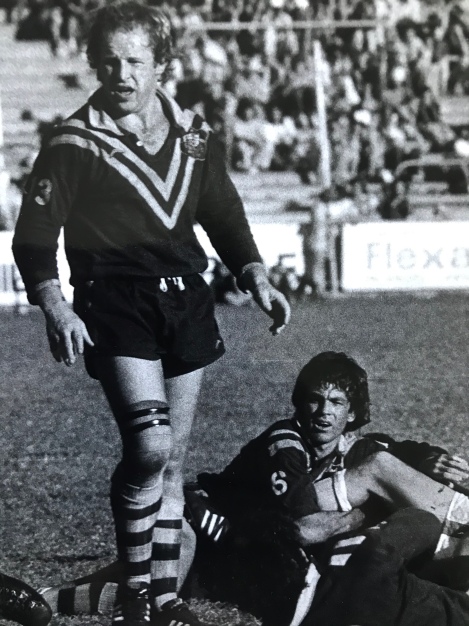Flashback to 1971 by Steve Ricketts
Story originally from stevericketts.com.au
Queensland Rugby League chairman, Bruce Hatcher retains fond memories of a time when some of the state’s best footballers were effectively put into isolation for two months, living under the one roof, away from family and friends.
In 1971, Brisbane Easts’ star, Hatcher, a former Brothers’ rugby union player, was named captain of the historic Queensland ‘Intensive Training squad’ – 20 men ‘forced’ to live in the spartan Lang Park dressing rooms, under the old Frank Burke Stand, sleeping on camp beds, and eating what was dished up to them. But unlike today’s Covid hotel lockdowns, there was plenty of space and time for exercise – perhaps too much time.
“Sunday was meant to be our rest day, but they took us to the Gold Coast for beach running and P.E.,” Hatcher recalled. “We would run along the beach until (fitness instructor) Col O’Brien would tell us to enter the surf, up to our knees, and continue to run and sprint. After a couple of hours, it was back on the bus to our home at Lang Park.
“We had dinner in the club, where the caterers were the Metassa family. Sometimes we had to put up with guest appearances from (recently retired State winger) Fonda Metassa, one of the real characters of the game, who would always have stuff to say.
“We were introduced to psychological and blood testing, every few days, to measure effort and health. There were physical challenges, such as how far you could run in 20 minutes; how many chin-ups and push-ups you could do.
“There were lectures by specialist doctors, and there even was the teaching of etiquette, including table manners, table setting and dining with a female companion; as well as public speaking.”
Queensland’s coach that year was Bob Bax, the man regarded as the ‘super coach’ of Brisbane club football.
One of the players in camp was future Super coach, Wayne Bennett, from Toowoomba.
Bax oversaw the camp and provided specialist skills coaching, bringing in former internationals, such as Duncan Hall, Barry Muir, and Peter Gallagher, as well as Great Britain Test halfback, Tommy Bishop, who was playing with Cronulla.
It was the first time in Australia, that a body contact sport had grouped players together under medical and psychological supervision.
Hatcher says some players openly rebelled, others complained and others appeared to feign injury.
“Fortunately, most maintained their sense of humour,” he said. “The rebellious moments involved players refusing to eat meals, and leaving the table, or deliberately arguing with the fitness instructor on work-loads.
“An incident in a friendly basketball match, almost involved an all-in-brawl, but the strong ties that had developed between the boys, stopped anything serious happening.
“When we attended social functions as a group, it was noticeable we became unintentionally unsociable. The boys tended to stick together, and would not easily accept other people into their environment. We had been through so much together. Five or six blokes had lost their jobs, because of the camp, and we were sick of the general attitude of outsiders, who thought it was an easy, relaxing affair”.
The medical tests showed that four players were natural left handers, but had been mainly taught to use their right. Norths’ winger, Bob Peut found out he was short sighted, and it was recommended he wear contact lenses.
At the end of the camp, the squad played matches against a South Qld rep. side and ‘Group 4’ from Country New South Wales, winning both games comfortably.
The camp was the brainchild of QRL president, the then Senator-elect, Ron McAuliffe. The money for the camp was provided by a consortium of sponsors, with their backing highlighting the essential link between business and rugby league.
The full squad was: Forwards: John McCabe (Valleys), Hugh O’Doherty (Valleys); John Lang, Des Morris (Easts); Greg Veivers (Souths), Richie Twist (Wests), Darryl Scheiwe (Redcliffe), Rod Hoffmeister (Ipswich), Ted Irvine (Toowoomba), Barry English (Gympie). Backs: Brian Adams, Glen Harrison, Bob Peut (Norths); Wayne Stewart (Wests), Bruce Hatcher (Easts), Les Barnes (Bundaberg), Lee Hutchinson (Nambour), Peter Videroni (Ipswich), Henry Williamson (Townsville), Wayne Bennett (Toowoomba).
Barnes and Hutchinson were late inclusions, following the withdrawal of first choice halfbacks, Johnny Brown (Norths) and Peter McDonald (Toowoomba). Scheiwe was called up after Tully’s Wayne Riley pulled out.
Bennett went on to play for Queensland and Australia that year; Stewart the year after, and Lang in 1973, while Veivers went on to captain Australia in 1977. Other squad members to go on to represent Queensland were McCabe, Twist, Harrison, Peut, Hutchinson, Adams and Williamson. Morris and O’Doherty had represented Queensland in seasons before the camp, and went on to win further State honours.
Also, in January, 1971, Mick Retchless, who led Valleys to the 1970 Brisbane premiership, said he had decided against retirement and would lead the Diehards again. Promising young forward, Russell Hughes, had been cleared to transfer from Wynnum-Manly to Valleys, after Wynnum initially played hard ball.
Souths announced they had signed Gavin McLaughlin from Newtown in Sydney, and Russell McNee from Ayr, in the Burdekin.

QRL chairman, Ron McAuliffe with members of the 1971 Intensive Training Squad (from left) Bob Peut, Henry Williamson and Les Barnes

Greg Veivers playing for Australia in 1977. That’s Johnny Peard on the deck.